
This module is a basic introduction to unit conversion using dimensional analysis.This lesson does not include square or cube units, or units in both the numerator and denominator.

This module is a basic introduction to unit conversion using dimensional analysis.This lesson does not include square or cube units, or units in both the numerator and denominator.
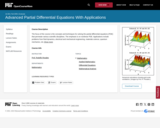
The focus of the course is the concepts and techniques for solving the partial differential equations (PDE) that permeate various scientific disciplines. The emphasis is on nonlinear PDE. Applications include problems from fluid dynamics, electrical and mechanical engineering, materials science, quantum mechanics, etc.
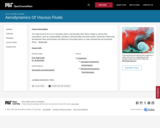
The major focus of 16.13 is on boundary layers, and boundary layer theory subject to various flow assumptions, such as compressibility, turbulence, dimensionality, and heat transfer. Parameters influencing aerodynamic flows and transition and influence of boundary layers on outer potential flow are presented, along with associated stall and drag mechanisms. Numerical solution techniques and exercises are included.
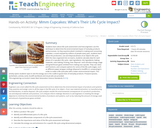
Students learn about life-cycle assessment and how engineers use this technique to determine the environmental impact of everyday products and processes. As they examine what’s involved in making and consuming cupcakes, a snack enjoyed by millions of people every year, students learn about the production, use and disposal phases of an object’s life cycle. With the class organized into six teams, students calculate data for each phase of a cupcake’s life cycle—wet ingredients, dry ingredients, baking materials, oven baking, frosting, liner disposal—and calculate energy usage and greenhouse gases emitted from making one cupcake. They use ratios and fractions, and compare options for some of the life-cycle stages, such as different paper wrapper endings (disposal to landfills or composting) in order to make a life-cycle plan with a lower environmental impact. This activity opens students’ eyes to see the energy use in the cradle-to-grave lives of everyday products. Pre/post-quizzes, worksheets, activity cards, Excel® workbook and visual aids are provided.

Learning Target: I can use dimensional analysis to convert units.
Students will explore different strategies to calculate feet per second to miles per hour.
Students will complete a group activity to find the speed of Barbie's car and convert the units of measure from feet per second to miles per hour.

In this course the fundamentals of fluid mechanics are developed in the context of naval architecture and ocean science and engineering. The various topics covered are: Transport theorem and conservation principles, Navier-Stokes’ equation, dimensional analysis, ideal and potential flows, vorticity and Kelvin’s theorem, hydrodynamic forces in potential flow, D’Alembert’s paradox, added-mass, slender-body theory, viscous-fluid flow, laminar and turbulent boundary layers, model testing, scaling laws, application of potential theory to surface waves, energy transport, wave/body forces, linearized theory of lifting surfaces, and experimental project in the towing tank or propeller tunnel.
This subject was originally offered in Course 13 (Department of Ocean Engineering) as 13.021. In 2005, ocean engineering became part of Course 2 (Department of Mechanical Engineering), and this subject was renumbered 2.20.
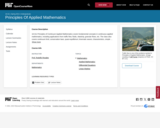
18.311 Principles of Continuum Applied Mathematics covers fundamental concepts in continuous applied mathematics, including applications from traffic flow, fluids, elasticity, granular flows, etc. The class also covers continuum limit; conservation laws, quasi-equilibrium; kinematic waves; characteristics, simple waves, shocks; diffusion (linear and nonlinear); numerical solution of wave equations; finite differences, consistency, stability; discrete and fast Fourier transforms; spectral methods; transforms and series (Fourier, Laplace). Additional topics may include sonic booms, Mach cone, caustics, lattices, dispersion, and group velocity.
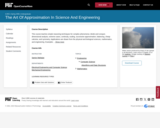
This course teaches simple reasoning techniques for complex phenomena: divide and conquer, dimensional analysis, extreme cases, continuity, scaling, successive approximation, balancing, cheap calculus, and symmetry. Applications are drawn from the physical and biological sciences, mathematics, and engineering. Examples include bird and machine flight, neuron biophysics, weather, prime numbers, and animal locomotion. Emphasis is on low-cost experiments to test ideas and on fostering curiosity about phenomena in the world.

These evaluative questions are designed to be used in the first semester of an introductory undergraduate-level General Chemistry course. They were designed to complement - but do not require use of - the Chemistry 2e OpenStax textbook.
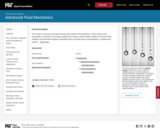
This course is a survey of principal concepts and methods of fluid dynamics. Topics include mass conservation, momentum, and energy equations for continua; Navier-Stokes equation for viscous flows; similarity and dimensional analysis; lubrication theory; boundary layers and separation; circulation and vorticity theorems; potential flow; introduction to turbulence; lift and drag; surface tension and surface tension driven flows.

This subject provides an introduction to the mechanics of materials and structures. You will be introduced to and become familiar with all relevant physical properties and fundamental laws governing the behavior of materials and structures and you will learn how to solve a variety of problems of interest to civil and environmental engineers. While there will be a chance for you to put your mathematical skills obtained in 18.01, 18.02, and eventually 18.03 to use in this subject, the emphasis is on the physical understanding of why a material or structure behaves the way it does in the engineering design of materials and structures.

This course teaches the art of guessing results and solving problems without doing a proof or an exact calculation. Techniques include extreme-cases reasoning, dimensional analysis, successive approximation, discretization, generalization, and pictorial analysis. Applications include mental calculation, solid geometry, musical intervals, logarithms, integration, infinite series, solitaire, and differential equations. (No epsilons or deltas are harmed by taking this course.) This course is offered during the Independent Activities Period (IAP), which is a special 4-week term at MIT that runs from the first week of January until the end of the month.

Students use a recipe to prepare a hydrogel gummy snack, which has a similar consistency to that found in a Haribo® gummy product. They must convert the juice and gelatin-based recipe from US customary units to metric units with dimensional analysis conversion. After unit conversion, teams are given different gelatin quantities and design their gummy snacks. Once the candies have solidified, student groups compare the gummy snacks are for viscosity and taste. After a taste test, teams reflect on their experiment and brainstorm ways to iterate a better gummy recipe.
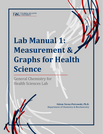
This work is an adaptation of the following OpenStax textbooks:Chemistry 2e, CC BY, access for free at https://openstax.org/books/chemistry-2e/pages/1-introduction Principles of Economics 2e, CC BY, access for free at https://openstax.org/books/principles-economics-2e/pages/1-introduction